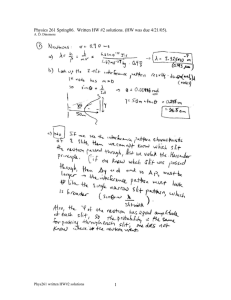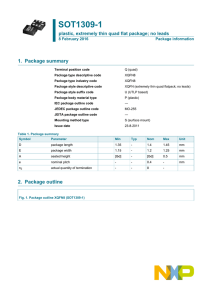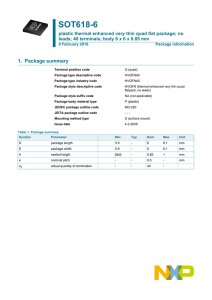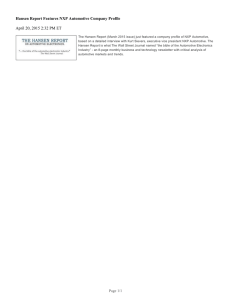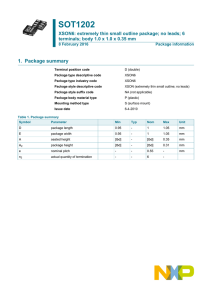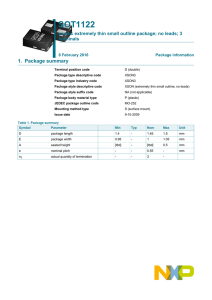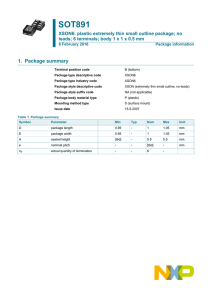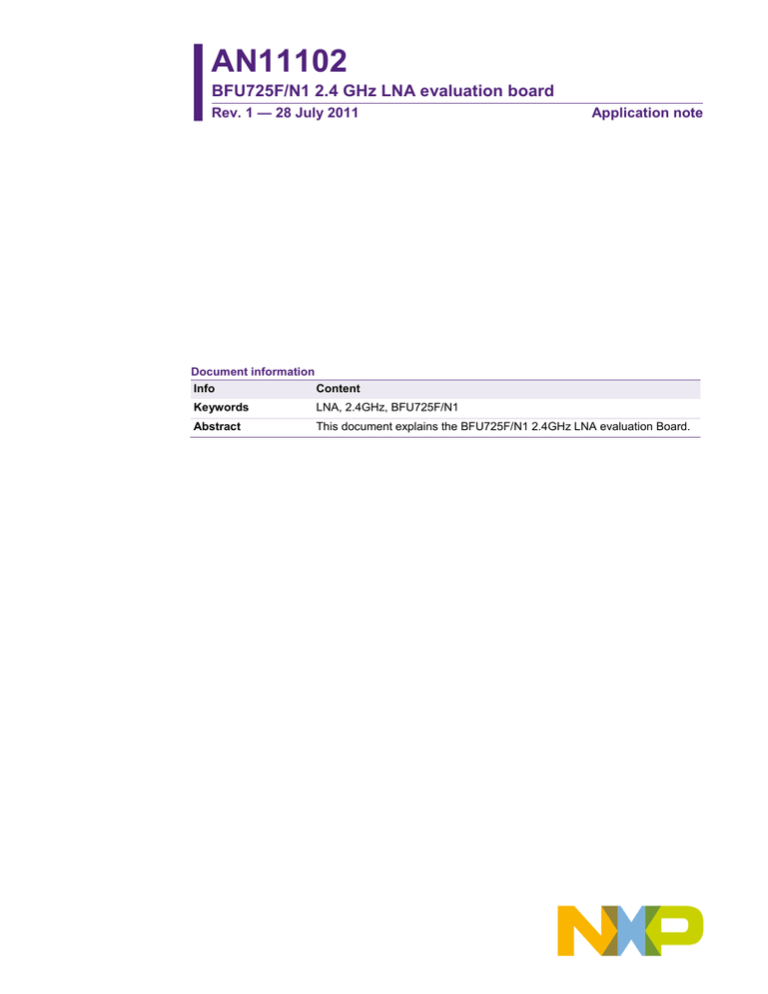
AN11102
BFU725F/N1 2.4 GHz LNA evaluation board
Rev. 1 — 28 July 2011
Application note
Document information
Info
Content
Keywords
LNA, 2.4GHz, BFU725F/N1
Abstract
This document explains the BFU725F/N1 2.4GHz LNA evaluation Board.
AN11102
NXP Semiconductors
BFU725F/N1_2.4GHz LNA EVB
Revision history
Rev
Date
Description
1
Initial document
20110728
Contact information
For more information, please visit: http://www.nxp.com
For sales office addresses, please send an email to: salesaddresses@nxp.com
AN11102
Application note
All information provided in this document is subject to legal disclaimers.
Rev. 1 — 28 July 2011
© NXP B.V. 2011. All rights reserved.
2 of 12
AN11102
NXP Semiconductors
BFU725F/N1_2.4GHz LNA EVB
1. Introduction
The BFU725F/N1 is a wideband Silicon Germanium Amplifier transistor for high speed,
low noise applications. It is designed to be used for LNA applications up to 15 GHz like
GPS, Satellite radio, Cordless Phone, Wireless LAN and satellite LNB. The BFU725F/N1
comes in a SOT343F package that has 2-emitter pins to reduce emitter inductance (for
maximum gain).
The BFU725F/N1 is ideal in all kind of applications where cost matters. It also gives the
designer flexibility in his design work, like bias current, frequency of operation; optimize
for the parameter of interest e.g. noise; gain; IP3 etc
The 2.4GHz LNA evaluation board (EVB) is designed to evaluate the performance of the
BFU725F/N1 applied as a general ISM band LNA in the 2.4GHz range. In this document,
the application diagram, board layout, bill of material, and some typical results are given.
Fig 1 shows the evaluation board.
Fig 1.
AN11102
Application note
BFU725F/N1 2.4GHz LNA evaluation board
All information provided in this document is subject to legal disclaimers.
Rev. 1 — 28 July 2011
© NXP B.V. 2011. All rights reserved.
3 of 12
AN11102
NXP Semiconductors
BFU725F/N1_2.4GHz LNA EVB
2. General description
The BFU725F/N1 is the first discrete HBT produced in NXPs SiGeC QuBIC4x BiCmos
process. SiGeC is a silicon germanium process with the addition of Carbon in the base
layer of the NPN transistor. The presence of carbon in the base layer suppresses the
boron diffusion during wafer processing that allows steeper and narrower SiGe HBT base
and a heavier doped base, this results in lower base resistance, hence lower noise and
higher cut off frequency (higher gain). In Table 1 a summary of the transistor
performance in terms of noise and gain is shown.
Table 1.
BFU725F/N1 figures
Measured at 2V Vce and 5mA Ic
Frequency
Noise Figure
Associated gain
1.5 GHz
0.42(dB)
24(dB)
1.8 GHz
0.43(dB)
22(dB)
2.4 GHz
0.47(dB)
20(dB)
5.8 GHz
0.7(dB)
13.5(dB)
12 GHz
1.1(dB)
10(dB)
Table 2.
Pin
Pinning information of the BFU725F/N1
Description
Simplified outline
1
Emitter
2
Base
3
Emitter
4
Collector
Graphic symbol
3. Application Board
The BFU725F/N1 2.4GHz EVB simplifies the evaluation of the BFU725F/N1 wideband
transistor, for this frequency range. The EVB enables testing of the device performance
and requires no additional support circuitry. The board is fully assembled with
BFU725F/N1, including input- and output matching, to optimize the performance. For
input matching a compromise has to be made for optimum noise/maximum
gain/RL/usable bandwidth on the application and customer requirements. To prevent
unwanted oscillations the stability factor (K) must be greater than 1. The stability factor
can be increased at the cost of gain. The board is mounted with signal input and output
SMA connectors for connection to RF test equipment.
AN11102
Application note
Table 3.
Design goals
Parameter
Symbol
BFU725F/N1 EVB
Unit
Noise Figure
NF
<1
dB
Power Gain
Gp
>15
dB
Input Return Loss
IRL
>5
dB
Output Return Loss
ORL
>5
dB
Stability factor
K
>1
-
All information provided in this document is subject to legal disclaimers.
Rev. 1 — 28 July 2011
© NXP B.V. 2011. All rights reserved.
4 of 12
AN11102
NXP Semiconductors
BFU725F/N1_2.4GHz LNA EVB
3.1 Application Circuit
In Fig 2 the application diagram as supplied on the evaluation board is given.
GND
VCC
GND
X3
R3
C5
R2
R1
C4
C6
C3
R5
R4
RF out
C2
L1
X2
RF in
C1
BFU725F
R6
X1
L3
Fig 2.
Circuit diagram of the evaluation board
3.2 Board Layout
Fig 3 shows the board layout with the components
Fig 3.
AN11102
Application note
Printed Circuit Board of BFU725F/N1 2.4GHz Evaluation Board
All information provided in this document is subject to legal disclaimers.
Rev. 1 — 28 July 2011
© NXP B.V. 2011. All rights reserved.
5 of 12
AN11102
NXP Semiconductors
BFU725F/N1_2.4GHz LNA EVB
3.3 PCB Layout
A good PCB Layout is an essential part of an RF circuit design. The EVB of the
BFU725F/N1 can serve as a guideline for laying out a board using either the
BFU725F/N1. Use controlled impedance lines for all high frequency inputs and outputs.
Bypass VCC with decoupling capacitors, preferable located as close as possible to the
device. For long bias lines it may be necessary to add decoupling capacitors along the
line further away from the device. Proper grounding the emitters is also essential for the
performance. Either connect the emitters directly to the ground plane or through vias, or
do both.
The material that has been used for the EVB is FR4 using the stack shown in Fig 4.
35um Cu
0.2mm FR4 Critical
35um Cu
0.8mm FR4 only for
mechanical rigidity of PCB
35um Cu
(1) Material supplier is ISOLA DURVAVER; εr=4.6-4.9: T
Fig 4.
Stack of PCB material
3.4 Bill of Materials
Table 4.
Bill of Materials
Designator Description
Footprint
Value
Supplier Name/type
Comment
C1
Capacitor
0402
15pF
MurataGRM1555
DC blocking *
C2
Capacitor
0402
2.7pF
MurataGRM1555
DC blocking *
C3,C6
Capacitor
0402
1.5pF
MurataGRM1555
LF Decoupling
C4,C5
Capacitor
0402
100nF
MurataGRM1555
LF Decoupling
(optional)
L1
Inductor
0402
12nH
Murata/LQW15A High Q low Rs
Input matching
L3
Inductor
0402
5.6nH
Murata/LQG15HS
Input matching
R1
Resistor
0402
0
Various
Not used
R2
Resistor
0402
51 k
Various
Bias setting
R3
Resistor
0402
100
Various
Bias setting
R4
Resistor
0402
0
Various
Not Used
R5
Resistor
0402
33
Various
Output matching
R6
Resistor
0402
27
Various
Output matching
X1,X2
SMA RF
connector
-
Johnson, End launch SMA 142-0701841
RF input/ RF output
X3
DC header
-
Molex, PCB header, Right Angle, 1 row,
3 way 90121-0763
Bias connector
AN11102
Application note
All information provided in this document is subject to legal disclaimers.
Rev. 1 — 28 July 2011
© NXP B.V. 2011. All rights reserved.
6 of 12
AN11102
NXP Semiconductors
BFU725F/N1_2.4GHz LNA EVB
4. Required Equipment
In order to measure the evaluation board the following is necessary.
DC Power Supply up to 30 mA at 3V.
An RF Signal generator capable of generating an RF signal at the operating
frequency of 2.4 GHz.
An RF spectrum analyzer that covers at least the operating frequency of 2.4 GHz
as well as a few of the harmonics, so up to 6 GHz should be sufficient.
”Optional” a version with the capability of measuring noise figure is convenient.
Amp meter to measure the supply current (optional).
A Network analyzer for measuring gain, return loss and reverse Isolation.
Noise figure analyzer.
5. Connections and Setup
The BFU725F/N1 2.4GHz EVB is fully assembled and tested. Please follow the steps
below for a step-by-step guide to operate the EVB and testing the device functions.
1. Connect the DC power supply set to 3V to the VCC and GND terminals.
2. Connect the RF signal generator and the Spectrum Analyzer; to the RF input and the
RF output of the EVB respectively. Do not turn on the RF output of the Signal
generator yet, set it to -35dBm output power at 2.4GHz, set the spectrum analyzer on
2.4GHz center frequency and a reference level of 0dBm.
3. Turn on the DC power supply and it should read approximately 8 mA.
4. Enable the RF output of the generator; the Spectrum analyzer displays a tone of
2.4GHz at around –20dBm.
5. Instead of using a signal generator and spectrum analyzer one can also use a
Network Analyzer NWA in order to measure Gain as well as in- and output return
loss
6. For Noise figure evaluation, either a Noise-figure analyzer or a spectrum analyzer
with noise option can be used. The use of a 5 dB noise source, like the Agilent 364B
is recommended. When measuring the noise figure of the evaluation board, any kind
of adaptors, cables etc between the noise source and the EVB should be avoided,
since this affects the noise performance.
AN11102
Application note
All information provided in this document is subject to legal disclaimers.
Rev. 1 — 28 July 2011
© NXP B.V. 2011. All rights reserved.
7 of 12
AN11102
NXP Semiconductors
BFU725F/N1_2.4GHz LNA EVB
Fig 5.
Evaluation board including its connections
6. Typical EVB Results
Table 5.
Typical results measured on the evaluation board
Parameter
Symbol
BFU725F/N1 EVB
Unit
Noise Figure
NF
1.0
dB
Power Gain
Gp
15.3
dB
Input Return Loss
IRL
6.0
dB
Output Return Loss
ORL
7.2
dB
Reverse Isolation
ISOrev
30.1
dB
Input 1dB Gain
Compression
IP1dB
-23.0
dBm
Input 1dB Gain
Compression
OP1dB
-8.7
dBm
Input third order
intercept point
IIP3
-1.6
dBm
Output third order
intercept point
OIP3
13.3
dBm
[1]
AN11102
Application note
Comment
[1]
The noise figure and gain figures are measured at the SMA connectors of the evaluation board. The
losses of the connectors and the PCB of approximately 0.1 dB are not subtracted.
All information provided in this document is subject to legal disclaimers.
Rev. 1 — 28 July 2011
© NXP B.V. 2011. All rights reserved.
8 of 12
AN11102
NXP Semiconductors
BFU725F/N1_2.4GHz LNA EVB
7. Legal information
7.1 Definitions
Draft — The document is a draft version only. The content is still under
internal review and subject to formal approval, which may result in
modifications or additions. NXP Semiconductors does not give any
representations or warranties as to the accuracy or completeness of
information included herein and shall have no liability for the consequences
of use of such information.
7.2 Disclaimers
Limited warranty and liability — Information in this document is believed to
be accurate and reliable. However, NXP Semiconductors does not give any
representations or warranties, expressed or implied, as to the accuracy or
completeness of such information and shall have no liability for the
consequences of use of such information.
In no event shall NXP Semiconductors be liable for any indirect, incidental,
punitive, special or consequential damages (including - without limitation lost profits, lost savings, business interruption, costs related to the removal
or replacement of any products or rework charges) whether or not such
damages are based on tort (including negligence), warranty, breach of
contract or any other legal theory.
Notwithstanding any damages that customer might incur for any reason
whatsoever, NXP Semiconductors’ aggregate and cumulative liability
towards customer for the products described herein shall be limited in
accordance with the Terms and conditions of commercial sale of NXP
Semiconductors.
Right to make changes — NXP Semiconductors reserves the right to make
changes to information published in this document, including without
limitation specifications and product descriptions, at any time and without
notice. This document supersedes and replaces all information supplied prior
to the publication hereof.
Suitability for use — NXP Semiconductors products are not designed,
authorized or warranted to be suitable for use in life support, life-critical or
safety-critical systems or equipment, nor in applications where failure or
malfunction of an NXP Semiconductors product can reasonably be expected
to result in personal injury, death or severe property or environmental
damage. NXP Semiconductors accepts no liability for inclusion and/or use of
NXP Semiconductors products in such equipment or applications and
therefore such inclusion and/or use is at the customer’s own risk.
Applications — Applications that are described herein for any of these
products are for illustrative purposes only. NXP Semiconductors makes no
representation or warranty that such applications will be suitable for the
specified use without further testing or modification.
Customers are responsible for the design and operation of their applications
and products using NXP Semiconductors products, and NXP
Semiconductors accepts no liability for any assistance with applications or
AN11102
Application note
customer product design. It is customer’s sole responsibility to determine
whether the NXP Semiconductors product is suitable and fit for the
customer’s applications and products planned, as well as for the planned
application and use of customer’s third party customer(s). Customers should
provide appropriate design and operating safeguards to minimize the risks
associated with their applications and products.
NXP Semiconductors does not accept any liability related to any default,
damage, costs or problem which is based on any weakness or default in the
customer’s applications or products, or the application or use by customer’s
third party customer(s). Customer is responsible for doing all necessary
testing for the customer’s applications and products using NXP
Semiconductors products in order to avoid a default of the applications and
the products or of the application or use by customer’s third party
customer(s). NXP does not accept any liability in this respect.
Export control — This document as well as the item(s) described herein
may be subject to export control regulations. Export might require a prior
authorization from national authorities.
Evaluation products — This product is provided on an “as is” and “with all
faults” basis for evaluation purposes only. NXP Semiconductors, its affiliates
and their suppliers expressly disclaim all warranties, whether express,
implied or statutory, including but not limited to the implied warranties of noninfringement, merchantability and fitness for a particular purpose. The entire
risk as to the quality, or arising out of the use or performance, of this product
remains with customer.
In no event shall NXP Semiconductors, its affiliates or their suppliers be
liable to customer for any special, indirect, consequential, punitive or
incidental damages (including without limitation damages for loss of
business, business interruption, loss of use, loss of data or information, and
the like) arising out the use of or inability to use the product, whether or not
based on tort (including negligence), strict liability, breach of contract, breach
of warranty or any other theory, even if advised of the possibility of such
damages.
Notwithstanding any damages that customer might incur for any reason
whatsoever (including without limitation, all damages referenced above and
all direct or general damages), the entire liability of NXP Semiconductors, its
affiliates and their suppliers and customer’s exclusive remedy for all of the
foregoing shall be limited to actual damages incurred by customer based on
reasonable reliance up to the greater of the amount actually paid by
customer for the product or five dollars (US$5.00). The foregoing limitations,
exclusions and disclaimers shall apply to the maximum extent permitted by
applicable law, even if any remedy fails of its essential purpose.
7.3 Trademarks
Notice: All referenced brands, product names, service names and
trademarks are property of their respective owners.
All information provided in this document is subject to legal disclaimers.
Rev. 1 — 28 July 2011
© NXP B.V. 2011. All rights reserved.
9 of 12
AN11102
NXP Semiconductors
BFU725F/N1_2.4GHz LNA EVB
8. List of figures
Fig 1.
Fig 2.
Fig 3.
Fig 4.
Fig 5.
BFU725F/N1 2.4GHz LNA evaluation board..... 3
Circuit diagram of the evaluation board ............ 5
Printed Circuit Board of BFU725F/N1 2.4GHz
Evaluation Board............................................... 5
Stack of PCB material ....................................... 6
Evaluation board including its connections ....... 8
AN11102
Application note
All information provided in this document is subject to legal disclaimers.
Rev. 1 — 28 July 2011
© NXP B.V. 2011. All rights reserved.
10 of 12
AN11102
NXP Semiconductors
BFU725F/N1_2.4GHz LNA EVB
9. List of tables
Table 1.
Table 2.
Table 3.
Table 4.
Table 5.
BFU725F/N1 figures ......................................... 4
Pinning information of the BFU725F/N1 ........... 4
Design goals ..................................................... 4
Bill of Materials.................................................. 6
Typical results measured on the evaluation
board ................................................................. 8
AN11102
Application note
All information provided in this document is subject to legal disclaimers.
Rev. 1 — 28 July 2011
© NXP B.V. 2011. All rights reserved.
11 of 12
AN11102
NXP Semiconductors
BFU725F/N1_2.4GHz LNA EVB
10. Contents
1.
2.
3.
3.1
3.2
3.3
3.4
4.
5.
6.
7.
7.1
7.2
7.3
8.
9.
10.
Introduction ......................................................... 3
General description ............................................. 4
Application Board ............................................... 4
Application Circuit .............................................. 5
Board Layout ...................................................... 5
PCB Layout ........................................................ 6
Bill of Materials ................................................... 6
Required Equipment ........................................... 7
Connections and Setup ...................................... 7
Typical EVB Results ............................................ 8
Legal information ................................................ 9
Definitions .......................................................... 9
Disclaimers......................................................... 9
Trademarks ........................................................ 9
List of figures..................................................... 10
List of tables ...................................................... 11
Contents ............................................................. 12
Please be aware that important notices concerning this document and the product(s)
described herein, have been included in the section 'Legal information'.
© NXP B.V. 2011.
All rights reserved.
For more information, visit: http://www.nxp.com
For sales office addresses, please send an email to: salesaddresses@nxp.com
Date of release: 28 July 2011
Document identifier: AN11102

